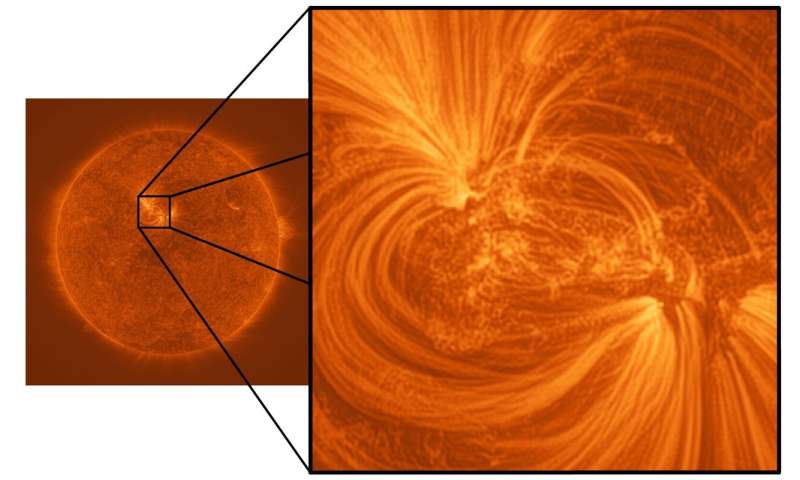|
|
Post by TheMooN on Mar 10, 2020 13:38:32 GMT
|
|
|
|
Post by MartinT on Mar 10, 2020 15:55:03 GMT
Phenomenal. That's a big chunk of rock, or more likely several fused together.
|
|
|
|
Post by TheMooN on Mar 10, 2020 18:46:38 GMT
We could all afford surround sound Vox Olympians!
|
|
|
|
Post by MartinT on Mar 11, 2020 12:34:02 GMT
|
|
|
|
Post by jandl100 on Mar 15, 2020 14:26:42 GMT
|
|
|
|
Post by jandl100 on Mar 18, 2020 19:55:12 GMT
|
|
|
|
Post by jandl100 on Mar 25, 2020 7:18:59 GMT
|
|
|
|
Post by MartinT on Mar 25, 2020 9:46:12 GMT
Wow!
|
|
|
|
Post by jandl100 on Mar 26, 2020 7:24:12 GMT
|
|
|
|
Post by jandl100 on Mar 26, 2020 16:27:36 GMT
|
|
|
|
Post by jandl100 on Apr 7, 2020 7:48:18 GMT
Totally awesome - A visual / infrared composite false colour image of Ssturn taken by the Cassini probe  'The upper layers in the atmospheres of gas giants - Saturn, Jupiter, Uranus and Neptune - are hot, just like Earth's. But unlike Earth, the Sun is too far from these outer planets to account for the high temperatures. Their heat source has been one of the great mysteries of planetary science. New analysis of data from NASA's Cassini spacecraft finds a viable explanation for what's keeping the upper layers of Saturn, and possibly the other gas giants, so hot: auroras at the planet's north and south poles. Electric currents, triggered by interactions between solar winds and charged particles from Saturn's moons, spark the auroras and heat the upper atmosphere.' www.jpl.nasa.gov/news/news.php?feature=7632&utm_source=iContact&utm_medium=email&utm_campaign=nasajpl&utm_content=daily-20200406-1 |
|
|
|
Post by MartinT on Apr 7, 2020 11:57:11 GMT
That looks like Saturn from the alternate dark universe!
|
|
|
|
Post by jandl100 on Apr 10, 2020 8:29:21 GMT
'highest-ever resolution images of the Sun from NASA's solar sounding rocket mission New images reveal fine threads of million-degree plasma woven throughout the Sun's atmosphere. The ultra-sharp images were taken by NASA's High-Resolution Coronal Imager (or Hi-C for short), a unique astronomical telescope carried into space on a sub-orbital rocket flight. The telescope can pick out structures in the Sun's atmosphere as small as 70km in size, or around 0.01% the size of the Sun, making these the highest resolution images ever taken of the Sun's atmosphere.' Good short vid on the link below.  phys.org/news/2020-04-images-reveal-fine-threads-million-degree.html?utm_source=nwletter&utm_medium=email&utm_campaign=daily-nwletter phys.org/news/2020-04-images-reveal-fine-threads-million-degree.html?utm_source=nwletter&utm_medium=email&utm_campaign=daily-nwletter |
|
|
|
Post by MartinT on Apr 10, 2020 9:19:26 GMT
Phenomenal. The power of our 'ordinary' star!
|
|
|
|
Post by jandl100 on Apr 11, 2020 6:24:54 GMT
|
|
|
|
Post by MartinT on Apr 11, 2020 8:11:46 GMT
Nice. That's going at a rate of knots!
|
|
|
|
Post by jandl100 on Apr 14, 2020 18:38:28 GMT
Even the coronavirus can't keep NASA's Curiosity Rover from continuing its exploration of the planet Mars. Working from home - controlling a rover on Mars. Amazing.  www.jpl.nasa.gov/news/news.php?feature=7638&utm_source=iContact&utm_medium=email&utm_campaign=nasajpl&utm_content=msl20200414-1 www.jpl.nasa.gov/news/news.php?feature=7638&utm_source=iContact&utm_medium=email&utm_campaign=nasajpl&utm_content=msl20200414-1"For people who are able to work remotely during this time of social distancing, video conferences and emails have helped bridge the gap. The same holds true for the team behind NASA's Curiosity Mars rover. They're dealing with the same challenges of so many remote workers - quieting the dog, sharing space with partners and family, remembering to step away from the desk from time to time - but with a twist: They're operating on Mars." |
|
|
|
Post by jandl100 on Apr 15, 2020 21:26:33 GMT
Dark Matter - opposed to the general concensus that it is composed of heavy sub-atomic particles [WIMPs - weakly interacting massive particles] that have yet to be discovered, maybe it is made up of truly vast numbers of 30 or so solar mass black holes that were created in the first thousandth of a second after the Big Bang that initiated the universe. In support of this idea, the first ever detection of gravitational waves in 2014 was the result of 2 merging black holes of around 30 solar masses. This was unexpected as previous theory indicated that black hole mergers would be rare events, and that black holes of that mass would also be rare. But this would be explained by a very large population of such primordial black holes making up the missing mass of the universe. Here's a vid os a simulation of what the two merging black holes would have looked like - the actual event would have taken about 1/3rd of a second, rather than the slowed down representation here - so about 100x faster. The swirling of the stars around it is due to the curvature of space time being stirred up by the rapidly rotating orbits of the black holes as they came together. www.sciencemag.org/news/2017/02/dark-matter-made-black-holesastronomynow.com/2016/05/24/possible-link-between-primordial-black-holes-and-dark-matter/ |
|
|
|
Post by Clive on Apr 15, 2020 22:27:14 GMT
It's hardly astronomy...but I've noticed how clear the stars are tonight. It could be a lack moisture in the air or is it a lack of pollution here just south of Manchester?
|
|
|
|
Post by MartinT on Apr 15, 2020 23:00:35 GMT
I have noticed it here, in Hampshire, too. Clear skies and very low noise levels.
|
|